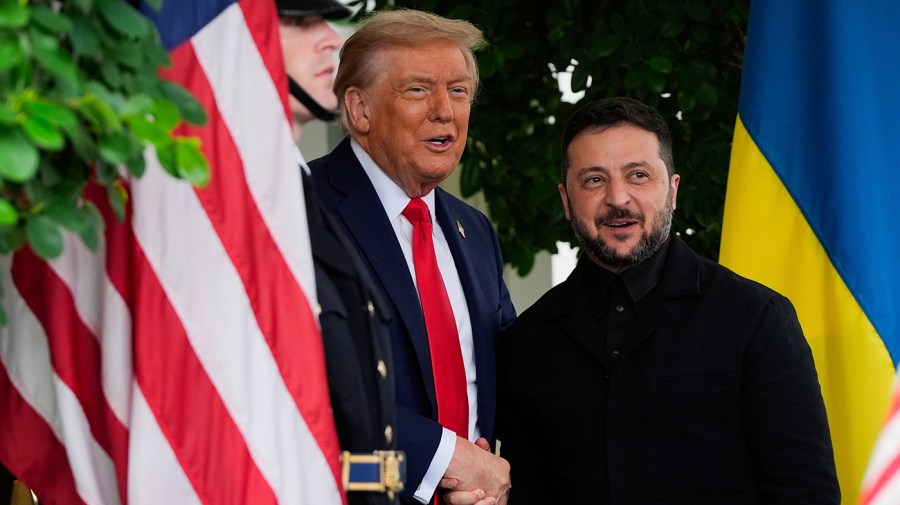The Memo: Trump turns from Gaza to Ukraine as Zelensky comes to town

President Trump has been buoyed by the ceasefire deal in Gaza, despite the many caveats that hang over the search for a durable peace between Israel and the Palestinians.
Now, with a wind in his sails from the Middle East, Trump turns to the Ukraine war. It’s a conflict he famously promised to resolve on his first day back in office. Yet it still burns almost a year after he won reelection.
Trump will meet with Ukrainian President Volodymyr Zelensky at the White House on Friday. It is expected to be a vastly different encounter from the fractious meeting between the two men that unfolded in late February.
Back then, Trump and Vice President Vance berated Zelensky, casting him as an ingrate with respect to the abundant U.S. aid that had gone to his nation.
These days, Trump’s frustrations seem to be more focused on Russian President Vladimir Putin, who has not been swayed by his American counterpart’s urging to bring the war to an end.
The conflict began with Russia’s February 2022 invasion of its neighbor.
Trump has grown frustrated with Putin’s apparent willingness to offer warm, vague words — and then ramp up military offensives regardless.
“We get a lot of bulls— thrown at us by Putin, [if] you want to know the truth,” Trump complained over the summer. “He’s very nice all the time, but it turns out to be meaningless.”
Trump’s latest plan to bring the recalcitrant Russian leader to heel includes threatening that he might supply Ukraine with Tomahawk missiles.
The weapons have a range of roughly 1,500 miles. The distance between Kyiv and Moscow is only about 500 miles.
“I might say, look, if this war is not going to get settled, I’m going to send them Tomahawks,” Trump mused to reporters traveling on his trip to the Middle East.
The president also said, of the Russians, “Do they want Tomahawks going in their direction? I don’t think so.”
The Tomahawk issue is by no means a done deal, though a Ukrainian delegation that arrived in the U.S. before Zelensky himself is understood to be pushing for it.
But the mere threat of the cruise missiles being provided has provoked anger from Moscow, where Putin’s circle has always warned against the dangers of escalation from Western powers that it blames for the war in the first place.
According to reporting from the BBC, Kremlin spokesperson Dmitry Peskov said the threat was emblematic of a perilous situation where “tensions are escalating from all sides.”
Peskov also said the idea of the Tomahawks being put at Ukraine’s disposal was causing “extreme concern” to Moscow. “What should the Russian Federation think? Just how should Russia react?” he asked.
Whatever happens from here, it’s a long way from roughly seven months ago, when the Trump administration announced it was “pausing and reviewing” its aid to Ukraine in the wake of the Trump-Zelensky-Vance debacle.
One notable pivot came in late April, when the U.S. and Ukraine agreed to a minerals deal that Trump characterized as a way for the Eastern European nation to compensate Washington for its assistance.
European nations have boosted support for Ukraine to make up for the suspension of most American direct aid. A July agreement also paved the way for NATO members to, in essence, pay for U.S. weapons that will ultimately be used by the Ukrainians.
Foreign policy experts argue that an even more important turning point may have been Trump’s much-heralded Alaska summit with Putin — and the president’s frustration over how little ultimately emerged from it.
The August meeting between the two men drew global headlines. But, even in the immediate aftermath, Putin was widely seen as having gotten the better of the encounter.
The Russian president was received with much pomp and ceremony — and a warm welcome from Trump, who invited Putin to ride with him in the presidential limousine known as “the Beast.”
Despite this, Putin avoided making any meaningful or concrete concessions. The broader White House effort to inject a shot of momentum into the peace process foundered — even though it did yield a more constructive meeting at the White House for Zelensky on Aug. 18. Talk of a trilateral meeting between Trump, Putin and Zelensky withered on the vine.
Even so, some voices that are often critical of Trump think Putin overplayed his hand during this period, opening up a new, wider gulf with the U.S. president.
“Putin miscalculated,” said Joel Rubin, who served as a deputy assistant secretary of State during the Obama administration. “This is a different Trump now, because of that Alaska summit — which was, for Trump, an initiative aimed at resolving something on which he had staked a lot of personal prestige. And it didn’t come to fruition.”
Rubin also argued that Trump has edged away from the isolationism on which he campaigned and that characterized the first months of his second term.
He pointed not only to the recent Gaza deal but to Trump’s willingness to greenlight American strikes on Iran in June.
There have also been other deeply controversial uses of American military force — notably the repeated strikes on boats off the coast of Venezuela, which the administration has claimed, often with no evidence, were manned by drug traffickers. Trump announced another such action on Tuesday.
Rubin, who made clear he disagrees with the strikes on the boats, nevertheless acknowledged that, in the broader scheme of things, “Putin can no longer take for granted that Trump will simply retreat into America First isolationism.”
Whether these changes will herald a wholesale reversal of Trump’s position on the Ukraine war is an open question.
But a president emboldened by Middle East success may be willing to roll the dice again with Zelensky this week.
The Memo is a reported column by Niall Stanage.